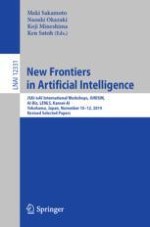2020 | Buch
New Frontiers in Artificial Intelligence
JSAI-isAI International Workshops, JURISIN, AI-Biz, LENLS, Kansei-AI, Yokohama, Japan, November 10–12, 2019, Revised Selected Papers
herausgegeben von: Maki Sakamoto, Naoaki Okazaki, Koji Mineshima, Ken Satoh
Verlag: Springer International Publishing
Buchreihe : Lecture Notes in Computer Science
